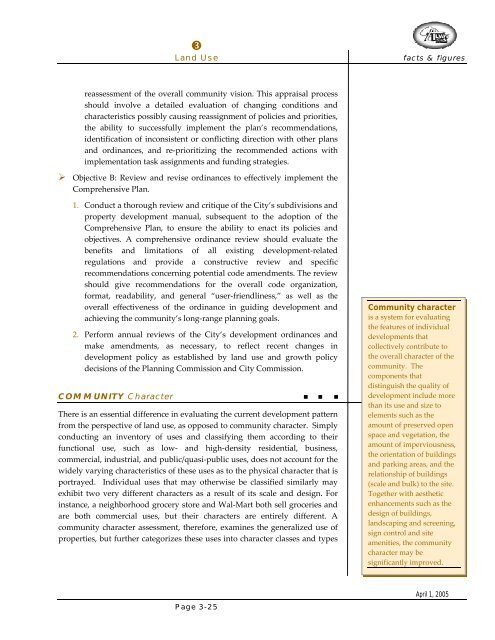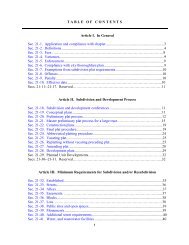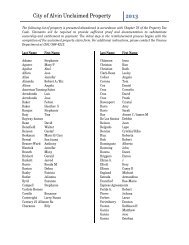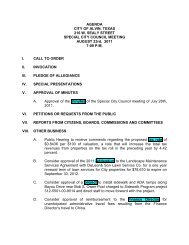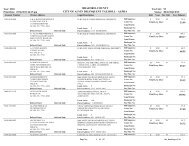Comprehensive Master Plan - City of Alvin
Comprehensive Master Plan - City of Alvin
Comprehensive Master Plan - City of Alvin
- No tags were found...
You also want an ePaper? Increase the reach of your titles
YUMPU automatically turns print PDFs into web optimized ePapers that Google loves.
Land Usefacts & figuresreassessment <strong>of</strong> the overall community vision. This appraisal processshould involve a detailed evaluation <strong>of</strong> changing conditions andcharacteristics possibly causing reassignment <strong>of</strong> policies and priorities,the ability to successfully implement the plan’s recommendations,identification <strong>of</strong> inconsistent or conflicting direction with other plansand ordinances, and re‐prioritizing the recommended actions withimplementation task assignments and funding strategies.‣ Objective B: Review and revise ordinances to effectively implement the<strong>Comprehensive</strong> <strong>Plan</strong>.1. Conduct a thorough review and critique <strong>of</strong> the <strong>City</strong>’s subdivisions andproperty development manual, subsequent to the adoption <strong>of</strong> the<strong>Comprehensive</strong> <strong>Plan</strong>, to ensure the ability to enact its policies andobjectives. A comprehensive ordinance review should evaluate thebenefits and limitations <strong>of</strong> all existing development‐relatedregulations and provide a constructive review and specificrecommendations concerning potential code amendments. The reviewshould give recommendations for the overall code organization,format, readability, and general “user‐friendliness,” as well as theoverall effectiveness <strong>of</strong> the ordinance in guiding development andachieving the community’s long‐range planning goals.2. Perform annual reviews <strong>of</strong> the <strong>City</strong>’s development ordinances andmake amendments, as necessary, to reflect recent changes indevelopment policy as established by land use and growth policydecisions <strong>of</strong> the <strong>Plan</strong>ning Commission and <strong>City</strong> Commission.COMMUNITY Character • • •There is an essential difference in evaluating the current development patternfrom the perspective <strong>of</strong> land use, as opposed to community character. Simplyconducting an inventory <strong>of</strong> uses and classifying them according to theirfunctional use, such as low‐ and high‐density residential, business,commercial, industrial, and public/quasi‐public uses, does not account for thewidely varying characteristics <strong>of</strong> these uses as to the physical character that isportrayed. Individual uses that may otherwise be classified similarly mayexhibit two very different characters as a result <strong>of</strong> its scale and design. Forinstance, a neighborhood grocery store and Wal‐Mart both sell groceries andare both commercial uses, but their characters are entirely different. Acommunity character assessment, therefore, examines the generalized use <strong>of</strong>properties, but further categorizes these uses into character classes and typesCommunity characteris a system for evaluatingthe features <strong>of</strong> individualdevelopments thatcollectively contribute tothe overall character <strong>of</strong> thecommunity. Thecomponents thatdistinguish the quality <strong>of</strong>development include morethan its use and size toelements such as theamount <strong>of</strong> preserved openspace and vegetation, theamount <strong>of</strong> imperviousness,the orientation <strong>of</strong> buildingsand parking areas, and therelationship <strong>of</strong> buildings(scale and bulk) to the site.Together with aestheticenhancements such as thedesign <strong>of</strong> buildings,landscaping and screening,sign control and siteamenities, the communitycharacter may besignificantly improved.Page 3-25April 1, 2005


